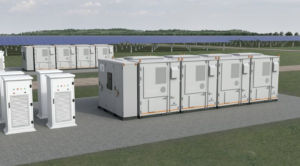Solar power plant repurposed to hunt asteroids at night – New Atlas

Report on the Dual-Use Application of Solar Heliostats for Asteroid Detection and its Contribution to Sustainable Development Goals
Introduction
A research initiative at Sandia National Laboratories is exploring a novel, dual-use application for concentrated solar power (CSP) infrastructure. The project, led by scientist John Sandusky at the National Solar Thermal Test Facility, aims to repurpose heliostat mirrors for astronomical observation, specifically asteroid detection, during nighttime hours when the facility is otherwise non-operational. This innovative approach enhances the value and utility of renewable energy assets, directly supporting several United Nations Sustainable Development Goals (SDGs).
Project Overview and Technical Methodology
The experiment leverages the existing infrastructure of the National Solar Thermal Test Facility, the only one of its kind in the United States. The facility’s primary function is generating 6 MWt of thermal power for research by using 218 heliostats to concentrate sunlight onto a central tower.
- Asset Repurposing: A single heliostat, normally used for tracking the sun, was reprogrammed to track the night sky.
- Data Collection: The heliostat was oscillated in a one-minute cycle, reflecting faint light from stars onto optical instruments located on the facility’s tower.
- Detection Method: Instead of capturing traditional photographic images, the system analyzes the photocurrent power spectrum of the incoming light. A moving object, such as an asteroid or spacecraft, creates a discernible frequency shift relative to the static background starlight, allowing for its detection.
This method provides a low-cost, supplementary tool for planetary defense and space domain awareness, capable of identifying objects that might otherwise go undetected by conventional telescopes.
Alignment with UN Sustainable Development Goals (SDGs)
This project significantly contributes to the advancement of global sustainability objectives by creating synergistic value from clean energy infrastructure.
- SDG 7: Affordable and Clean Energy: By developing a secondary function for solar power stations, the project increases the overall economic viability and return on investment for clean energy infrastructure. Maximizing the utility of these assets 24 hours a day makes renewable energy a more attractive and sustainable proposition.
- SDG 9: Industry, Innovation, and Infrastructure: The research is a prime example of innovation that builds resilient infrastructure. It demonstrates how existing industrial assets can be adapted for new, high-value scientific purposes, enhancing their functionality and contribution to society without requiring new construction.
- SDG 11: Sustainable Cities and Communities: A core target of SDG 11 is to protect populations from natural disasters. This project directly supports this goal by enhancing humanity’s capacity to detect Near-Earth Objects (NEOs). Early detection of potentially hazardous asteroids is the first step in planetary defense, safeguarding communities from catastrophic impact events.
- SDG 17: Partnerships for the Goals: The initiative exemplifies effective collaboration. It involves a national laboratory, presents findings to the international scientific community (International Society for Optics and Photonics), and has the potential to supplement the work of other agencies like NASA’s Asteroid Terrestrial-impact Last Alert System (ATLAS), fostering partnerships to achieve shared safety and scientific goals.
Future Outlook and Scalability
The initial results have successfully demonstrated the proof-of-concept. The project’s future direction focuses on scaling the technology to utilize multiple heliostats simultaneously. The primary objectives are to enhance detection sensitivity for smaller asteroids and to formally demonstrate the system’s capability as a valuable component in the global network for NEO detection. This would transform idle solar facilities worldwide into a distributed network for planetary defense, further embedding clean energy infrastructure into the fabric of global security and sustainable development.
1. Which SDGs are addressed or connected to the issues highlighted in the article?
The article discusses a project that connects to several Sustainable Development Goals by focusing on renewable energy infrastructure, scientific innovation, and planetary safety.
-
SDG 7: Affordable and Clean Energy
The article is centered around a solar power station, specifically the “National Solar Thermal Test Facility.” This directly relates to the promotion of clean and renewable energy sources. The innovation aims to increase the overall utility and value of such facilities, which can encourage further investment in clean energy.
-
SDG 9: Industry, Innovation and Infrastructure
The core of the article is about a “Laboratory Directed Research and Development project” that represents a significant scientific innovation. It focuses on upgrading the use of existing sustainable infrastructure (the solar plant’s heliostats) for a new scientific purpose, thereby enhancing its technological capability.
-
SDG 11: Sustainable Cities and Communities
The project’s application in detecting asteroids connects to making human settlements safer. The article explicitly mentions that the system could supplement efforts to seek out “potentially dangerous asteroids,” which is a form of disaster risk reduction to protect communities from a potential impact event.
2. What specific targets under those SDGs can be identified based on the article’s content?
Based on the issues discussed, the following specific targets can be identified:
-
SDG 7: Affordable and Clean Energy
- Target 7.2: “By 2030, increase substantially the share of renewable energy in the global energy mix.” The article discusses a solar thermal power facility, which is a key component of increasing the share of renewable energy. The project makes this infrastructure more valuable, which could incentivize the development of more solar plants.
- Target 7.a: “By 2030, enhance international cooperation to facilitate access to clean energy research and technology… and promote investment in energy infrastructure and clean energy technology.” The project at Sandia National Laboratories is a prime example of research and development in clean energy technology. Presenting the research at the “International Society for Optics and Photonics” conference facilitates the sharing of this new technology.
-
SDG 9: Industry, Innovation and Infrastructure
- Target 9.1: “Develop quality, reliable, sustainable and resilient infrastructure… to support economic development and human well-being.” The article focuses on making sustainable infrastructure (a solar power plant) more resilient and useful by giving it a function even when it is not generating power, thus maximizing its value.
- Target 9.5: “Enhance scientific research, upgrade the technological capabilities of industrial sectors in all countries… encouraging innovation…” The project is a direct example of this target. It is a “Laboratory Directed Research and Development project” designed to find a novel use for heliostats, thereby enhancing scientific research and upgrading the technological capabilities of the solar energy sector.
-
SDG 11: Sustainable Cities and Communities
- Target 11.5: “By 2030, significantly reduce the number of deaths and the number of people affected and substantially decrease the direct economic losses… caused by disasters…” The article states the new technique could be a “low-cost supplement to NASA’s Asteroid Terrestrial-impact Last Alert System (ATLAS), which is designed to seek out potentially dangerous asteroids.” This directly contributes to global systems for disaster risk reduction against asteroid impacts.
3. Are there any indicators mentioned or implied in the article that can be used to measure progress towards the identified targets?
Yes, the article contains several explicit and implicit indicators that can measure progress:
-
Indicators for SDG 7
- Renewable energy capacity: The article mentions the facility can generate “6 MWt of power,” which is a direct measure of the capacity of this clean energy infrastructure.
- Investment in clean energy research: The existence of the “Laboratory Directed Research and Development project” itself is an indicator of investment in clean energy technology research.
-
Indicators for SDG 9
- Research and development activity: The project itself, conducted by scientist John Sandusky at Sandia National Laboratories, is a clear indicator of R&D. The article further notes the research was presented at a “conference of the International Society for Optics and Photonics,” which is an indicator of the dissemination of scientific research.
- Technological advancement: The development of the technique itself, which “captures the photocurrent power spectrum of incoming light at sub-milliHertz resolution” to detect a “frequency shift,” is a measurable technological advancement. The goal to “scale up from one heliostat to many” and “detect even smaller asteroids” serves as a metric for future progress.
-
Indicators for SDG 11
- Enhanced disaster monitoring capability: The primary outcome of the project is an enhanced capability to detect near-Earth objects. The ability to supplement the “Asteroid Terrestrial-impact Last Alert System (ATLAS)” is a direct indicator of progress in strengthening early warning systems for natural disasters.
4. Create a table with three columns titled ‘SDGs, Targets and Indicators” to present the findings from analyzing the article. In this table, list the Sustainable Development Goals (SDGs), their corresponding targets, and the specific indicators identified in the article.
| SDGs | Targets | Indicators |
|---|---|---|
| SDG 7: Affordable and Clean Energy |
7.2: Increase the share of renewable energy.
7.a: Enhance access to clean energy research and technology. |
– Capacity of the solar thermal plant (6 MWt of power). – The existence of the “Laboratory Directed Research and Development project” focused on solar technology. |
| SDG 9: Industry, Innovation and Infrastructure |
9.1: Develop quality, reliable, sustainable and resilient infrastructure.
9.5: Enhance scientific research and encourage innovation. |
– Repurposing idle solar infrastructure (heliostats) for nighttime use. – The research project presented at an international science conference (International Society for Optics and Photonics). – The goal to “scale up from one heliostat to many” and “detect even smaller asteroids.” |
| SDG 11: Sustainable Cities and Communities | 11.5: Reduce deaths and economic losses from disasters. |
– The development of a low-cost method to supplement NASA’s Asteroid Terrestrial-impact Last Alert System (ATLAS). – The demonstrated capability to detect objects (asteroids, spacecraft) via frequency shifts in starlight. |
Source: newatlas.com

What is Your Reaction?
 Like
0
Like
0
 Dislike
0
Dislike
0
 Love
0
Love
0
 Funny
0
Funny
0
 Angry
0
Angry
0
 Sad
0
Sad
0
 Wow
0
Wow
0













































































